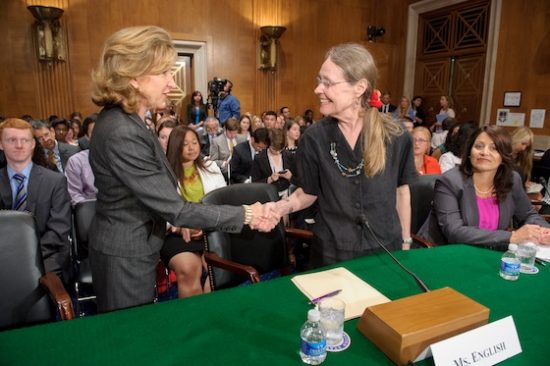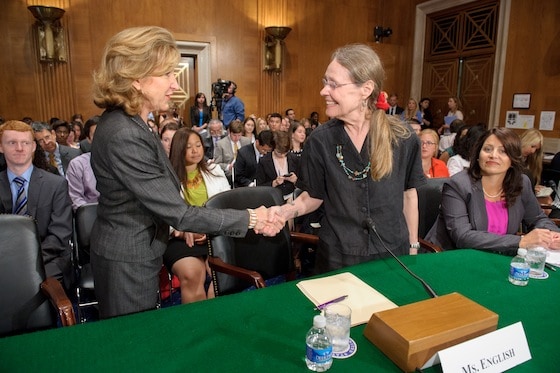By Casey King
On July 8th a congressional hearing of the Subcommittee on Children and Families took place entitled, “Falling Through the Cracks: The Challenges of Prevention and Identification in Child Trafficking and Private Re-homing.” The hearing was lead by Senator Kay Hagan of North Carolina and included testimonies from four panelists.
Senator Hagan brought the issues of children, who are victims of human trafficking, being unidentified, misidentified, or unreported to light. She says that a main factor of this problem going unsolved in the lack of training and tools given to educators, health care providers and social workers. These professionals need guidance to help prevent vulnerable children from entering the dangerous world of human trafficking.
With some reports of nearly 300,000 children in the U.S being trafficked, and the average age being 11-14 years old, educators play an important role in teaching children and adolescents the dangers of trafficking. Health care providers need policies and protocols to insure that they can successfully identify children who are in trouble. Senator Hagan says that we “need leadership from the federal government” in order to help ensure that vulnerable children are protected and identified.
Another important topic was private re-homing. A term many people have not heard before, is originally used to refer to the relocation of pets. However, today the term refers to advertisement and relocation of adopted children by their adoptive parents, who feel they can no longer raise the child they had originally adopted. These children are advertised online for anyone who is willing to take them, which results in the re-homing of children to adults who have a history of abuse, neglect, and sexual exploitation of children.
Ms. JooYeun Chang is the Associate Commissioner for the Department of Health and Human Services Children’s Bureau. She shared the Bureau’s reaction to the issues of human trafficking and private re-homing. On the issue of human trafficking, the Children’s Bureau is focusing on capacity building. Which should include institutional education, staff training, supporting policies and procedures, appropriate screening, resource development and data collection in order to decrease children’s vulnerability to trafficking and increase early identification of trafficking victims. The Bureau also wants to provide states information on human-trafficking in order to build awareness and create a better response to the issue. In order to do this, the Children’s Bureau has decided to award grants this year to continue the development of the children welfare system’s response to human trafficking. This year as well, Ms. Chang states the Children’s Bureau has released new guidance for states in the form of an information memorandum to support the children and family’s affected by disputed adoptions. The memorandum encourages states to inform families of post-adoption services, to review adoption processes, and to provide support to adoptive families before they are in crisis.
The second panelist to speak was Ms. Abigail English, who is the Director for the Center for Adolescent Health & the Law in Chapel Hill North Carolina. She addressed the need for educators to begin teaching the dangers and preventive methods of human trafficking as if they would teach drug prevention or sex education. She also emphasized the need for every state to adopt some type of Safe Harbor laws, which would get sex trafficked children help instead of criminal records. Ms. English believes that children who are forced into prostitution should not be treated as criminals, an idea that is one of the Institute of Medicine’s fundamental principles. As well as the idea that human trafficking and exploitation of children should be seen as child abuse, and that identification and interventions of trafficked children should do no harm towards the children. However, when health care professionals try to identify the children as victims or prevent a child from becoming a victim there are issues that get in their way. Health care professionals may have a lack of understanding or awareness of the warning signs, victims may not feel comfortable to tell the truth, and there is a lack of policy and protocol to guide the health care provider. Ms. English feels that combinations of these barriers are preventing child sex trafficking victims and soon to be victims from being identified.
The third panelist was Ms. Jenee Littrell, the Assistant Principal of Grossmont Union High School District in San Diego County, California. She has some great insight on how much of an impact school administration and staff can have on identifying and preventing trafficking victims because she understands that these may be the only responsible adults these children come into contact with. She says, “schools play a critical role in protecting students and they need proper training and support to do so”. With her four-step program she has identified countless victims of sex trafficking in her district. The program includes increasing staff awareness and education on the indicators of sex trafficking, increasing student awareness of the risks of trafficking, having clear district protocol for identifying suspected victims, and strong partnerships with law enforcement, child welfare, and social services. She has created such a successful plan by doing her research, which includes asking survivors of sex trafficking how they think schools should handle the issue. One survivor says that educators should “watch it and address it, (because) we know that you are aware it is happening”.
The last panelist to speak was Ms. Megan Twohey, an investigative reporter. Ms. Twohey conducted an eye-opening investigation on the world of private re-homing. She monitored public online forums for parents in disrupted adoptions, parents who feel they cannot take care of the child they adopted, for five years. Over that time, there were 5,000 messages and 261 identified children who were advertised online to be given to new families. On average, this resulted in one child per week being offered to an unknown adult over the internet, without any type of background check or follow-up. Ms. Twohey shared a story of a mother who handed off her adopted son to a woman in a parking lot, who’s biological children were removed from her custody and who’s husband is now in jail for child pornography. With no law that specifically prohibits private re-homing, adoptive parents can advertise their adopted children online without ever breaking a federal law.
As the hearing concluded, Senator Hagan seemed determine and hopeful to combine the efforts of lawmakers, educators, law enforcement, and health care professionals to give children and adolescences the help they need to prevent and identify the victims of human trafficking, as well as regulating and protecting private re-homing.

